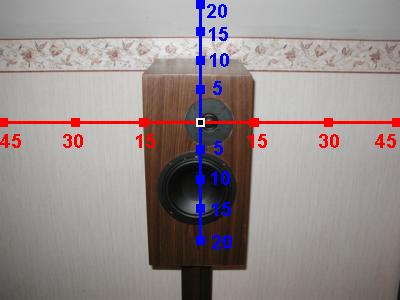
 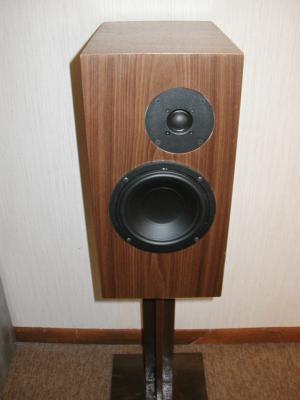
IntroductionThe Extremis is a 2-way fullrange speaker design using Adire Audio's Extremis 6.8 woofer along with the Seas 27TDFC(H1189) 1" fabric dome tweeter. The unique feature of the Extremis design is the fact that it is a small 2-way speaker that covers a wider frequency range than most 3-way tower speakers due to the extraordinary bass capabilities of the Extremis 6.8 woofer. There is a tradeoff, however, in order to get a 6.5" woofer to play that deep some efficiency must be sacrificed and the overall efficiency of the Extremis design is around 80dB @1W/1meter. Due to its low efficiency the Extremis is a better match for solid state amplifiers as opposed to lower power tube amps. My 100 watt Yamaha integrated amplifier provides more than enough power to get the Extremis shaking the house and knocking the pictures off the wall so their low efficiency shouldn't be too much of an issue for most amps. I was able to get a very flat, nice sounding frequency response with these drivers and the Extremis design is simply amazing with its combination of balanced, natural sound with in-room bass response down below 25Hz.DriversSeas 27TDFC(H1189) 27mm High Definition precoated fabric dome tweeter with a wide, soft polymer surround. The dome and surround materials give high consistency and excellent stability against variations in air humidity. The voice coil is wound on an aluminum voice coil former with adequate ventilating holes to eliminate noise from internal air flow. The voice coil is immersed in low viscosity magnetic fluid, for high power handling capacity and simplified crossover design. A stiff and stable rear chamber with optimal acoustic damping allows 27TDC to be used with moderately low crossover frequencies. The chassis is precision moulded from glass fibre reinforced plastic, and its front design offers optimum radiation conditions.Adire Audio Extremis 6.8 Available at Adire Audio The Extremis 6.8 is a high performance midwoofer with a cast aluminum frame, suitable for use in mid-sized ported and sealed cabinets. It has an exponentially flared polypropylene cone, concave/flat polypropylene dustcap, rubber surround for excellent cone termination. The driver has an aluminum former with a 4 layer copper wound voice coil for high power handling. A progressive spider with flat landing attachment is used to ensure linear suspension operation. The motor uses a neodymium magnet mounted on the pole to create an extremely compact, inherently video shielded motor structure. The motor uses our patent-pending XBL2™ motor for extreme linearity over the entire range of motion. This motor yield a very high motor force factor of 9 Newtons per Ampere, and maintains over 90% of its peak force over the center 20mm of excursion. Combined with a linear excursion rating of 13mm one way this motor yields the highest level of low distortion stroke available in any 6.5”/7” woofer on the market today. The flat progressive spider and soft rubber surround combine to yield an extremely linear suspension as well. Suspension compliance has less than a 25% change over the center 20mm of excursion, and provides a full 26mm of peak to peak throw capability to equal that of the motor. Inductance nonlinearities are kept to a minimum by the use of a full copper sleeve on the pole. This sleeve is a full 1mm thick copper ring that extends 9mm beyond the top plate. The result is a very low inductance of 0.13 mH, and inductance that does not change by more than 15% over the entire usable range of throw. Cabinet DesignThe cabinet for the Extremis is roughly 24 liters with a port tuning frequency of 32Hz. I used a 2" flared port which allows me to use a shorter port length than a larger diameter port which is helpful when trying to reach such a low port tuning frequency in this relatively small enclosure. Simulations reveal that this cabinet should yield a -3dB frequency of around 32Hz but nearfield measurements seem to indicate that f3 is closer to 29Hz which is unheard of from a 6.5" woofer in such a small cabinet. There aren't even many 8" woofers using cabinets twice this size that can come close to playing this deep and still perform at a high enough frequency to blend with a tweeter at 2kHz. I used a piece of 1/8" masonite on the front baffle with a hole cut out for the tweeter in order to flush mount the tweeter. The woofer is surface mounted in order to closer align the acoustic centers of the drivers which effectively moves the ideal listening axis up a bit. I designed the cabinet without a grill and offset the tweeter to reduce diffraction effects. The cabinets should be built as mirrored pairs with the tweeter towards the outside edge. The crossovers are mounted to the back of the cabinet using screws that are accessible through the woofer opening. I used about 1/2 lbs. of Acousta-stuf in the back of the cabinet behind the woofer. Click on the pic below for more cabinet pics.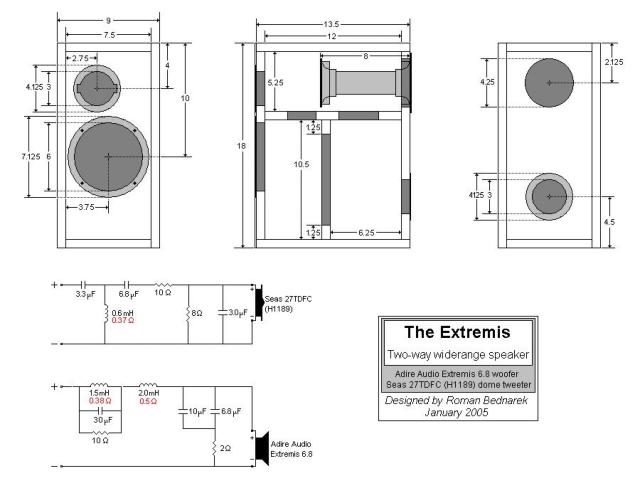 Crossover DesignFor the crossover I chose to use the common 4th order Linkwitz-Riley filter for several reasons. The 4th order filter allows me to use a lower crossover frequency which takes some of the dips and peaks present in the Extremis 6.8's upper frequency response. This type of filter also makes it easier to obtain good phase alignment on-axis with the tweeter which I've often found difficult to do with 2nd order filters. The crossover frequency is around 2000 Hz which is still high enough for the 27TDFC to handle due to the steeper filter slopes. The tweeter filter is a typical third order electrical filter with a fixed L-pad for attenuation. I added a 3uF capacitor parallel to the tweeter in order to reduce the 15kHz peak that is present in the tweeter's raw response. This 3uF capacitor becomes a short at higher frequencies but the large 10 ohm series resistor prevents the overall impedance of the filter from dropping below 10 ohms. There is still a very slight peak in this region but as you move off-axis this peak quickly becomes a dip. I had to use a lot of attenuation to get the tweeter level low enough to match the woofer output as can be seen by the large series resistor and small parallel resistor in the tweeter L-pad network. This is the first design I've seen which the series resistor is larger than the parallel resistor. The woofer filter is essentially a second order electrical filter with a parallel notch filter in series with it. There is an added resistor in series with the parallel woofer capacitor which allows me to tailor the slope of the upper frequency rolloff. The 2.0mH inductor is primarily used for baffle step compensation and I chose to use a 15 gauge air core inductor. The parallel LCR trap is used to remove a peak that is present in the woofer's raw response in the 600Hz-1200Hz region. This parallel trap also assists in compensating for baffle step losses as well. Below is a picture of my crossover layout.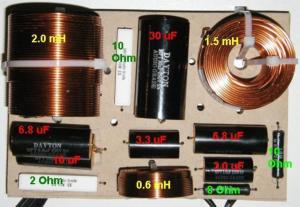 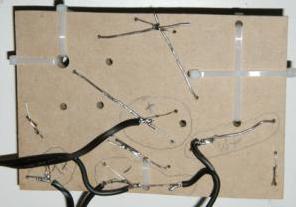 Performance
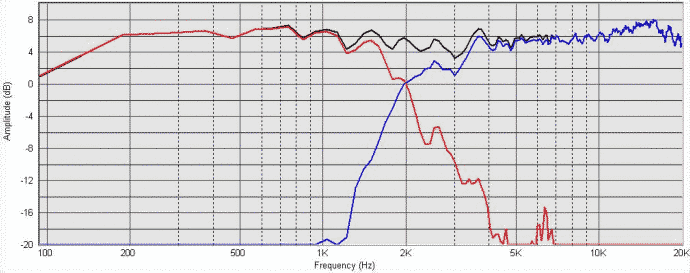
I spent weeks tweaking the crossover and I finally arrived at a design that sounds very nice. I used my Asterion design as a reference point when adjusting crossover components. The polypropylene Extremis 6.8 woofer definitely has a different character than the wood-pulp Vifa XT18 woofer used in the Asterion design but I wouldn't say that the Extremis is any less detailed. The XT18 seems to have more energy in the 200-500Hz region that makes it sound a bit fuller in the midrange than the Extremis but the Extremis has a crispness that gives them a cleaner presentation of vocals. Due to this midrange crispness I chose to go with a little bit extra baffle step compensation to give them a fuller sound without being too strong in the bass. Overall the response is pretty balanced as indicated by the response plot and they have a natural sound where there aren't any frequencies that stick out. They are inefficient at around 80dB but they can handle a lot of power and the nice thing about them is as you crank up the volume the woofers don't compress like most do so the sound doesn't get shrill but remains balanced and warm. As I mentioned before these woofers have remarkable bass extension especially for a 24 liter enclosure. With a sine sweep bass notes can be heard clearly down to 25Hz in my small listening room. Overall I would have to say that I'm pretty satisfied with the performance of this design which is very unique due to the extreme bass extension. In hindsight I've come to the conclusion that the ideal application for the Extremis 6.8 would be to use a pair of them in parallel because they have a rather high impedance and the efficiency would be improved. I would also probably add a dome midrange to the design to take some of those peaks and dips out of the picture. So a narrow tower using dual Extremis 6.8 woofers, a dome midrange and a dome or ribbon tweeter would be an interesting design but I don't have the budget to explore such a project and I'm kinda itching to work with a rigid cone driver next. Speaker Workshop Project FileThe Speaker Workshop project file for this design is now available for download: Extremis.swd. This project file includes gated measurements for the drivers at different listening axes (TA stands for "Tweeter Axis" and TAelev means that the speaker was higher off of the floor when the measurement was taken). There are nearfield woofer measurements and port measurements as well. There's also a crossover network simulation based on measurements taken on axis with the tweeter. The file is about 2 MB so be patient if you have a slower connection. |
